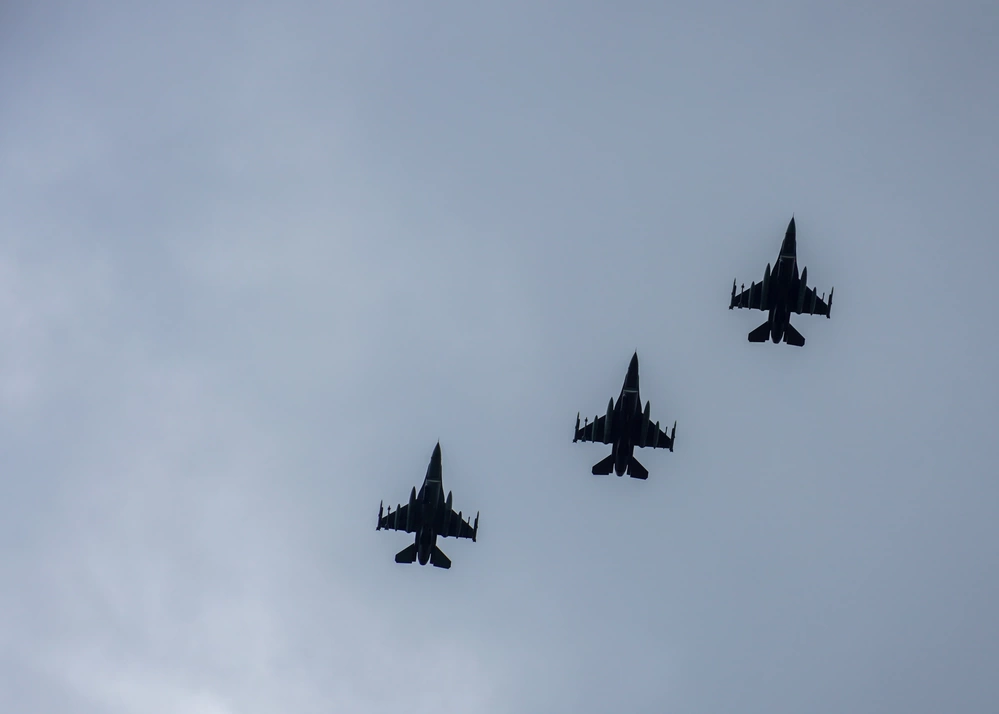On Monday, more than 250 aircraft and 10,000 personnel from 25 countries kicked off NATO’s largest air exercise in the alliance’s history. The Air Defender exercise, which is hosted and headed by Germany, simulates NATO’s response following an attack on one of its members by a third country.
“Air Defender sends a clear message that NATO is ready to defend every inch of Allied territory,” Oana Lungescu the alliance’s spokesperson said.
Finland, the alliance’s newest member, is also participating in the exercise, as is Sweden, which has applied to join the alliance, and NATO partner Japan.
Collective defense on a large scale
NATO is underpinned by its famous Article 5, according to which an attack against one of the alliance’s 31 members is considered an attack against all. Article 5 has only been invoked once in the alliance’s history, following the 9/11 attacks against the United States.
NATO conducts frequent multilateral exercises across all domains, but exercises on the scale of Air Defender are very rare.
“Air Defender is necessary because we live in a more dangerous world. As we face the biggest security crisis in a generation, we stand united to keep our countries and our people safe,” Lungescu said.
More than 20 different types of aircraft are participating in the exercise, including JAS 39 Gripens, Eurofighter Typhoons, F-18 Hornets, F-16 Fighting Falcons, and fifth-generation F-35 Lighting II stealth aircraft.

The U.S. is participating in the exercise with approximately 100 aircraft from various National Guard squadrons. The size of the American contribution demonstrates “the strong bond between Europe and North America, working together in NATO,” Lungescu added.
Among the platforms that the U.S. has sent to Air Defender are A-10 Warthogs, which specialize in close-air support and were designed to take out Soviet tanks, and F-35s. The multirole F-35 is the most technologically advanced combat aircraft in the world and by far the most ubiquitous stealth aircraft in service.
“Training like this is important, because in the next conflict, when we may be called upon to defend NATO, [we’re] not going to get a practice round,” Major Adam Broadway Casey, an A-10 pilot with the 107th Fighter Squadron, 127th Fighter Wing, Michigan National Guard said.
“As an A-10 pilot, I don’t want the first time I check in on station with a German JTAC, to be when enemy tanks are crossing the border into NATO,” Major Casey added referring to the ground troops that specialize in calling in air support, which is a very sensitive task that requires close coordination with pilots.
Related: America’s massive military advantage nobody talks about: 500+ Refueling Aircraft
Wings over Europe

Aircraft will take off from a number of airbases across Germany, the Netherlands, and the Czech Republic. Although Air Defender will primarily take place in three areas over Germany, missions will also be held over Romania and the Baltic region.
The Baltic is particularly important to NATO. The three small Baltic states —Estonia, Lithuania, and Latvia —border Russia and used to be part of the Soviet Union until its collapse. To deter Russia, NATO already has three battlegroups in the region, illustrating its importance.
During the exercise, NATO will be flying dozens of different aircraft at the same time. This contrasts with the capabilities of the Russian military, which has been unable to conduct large-scale air operations in Ukraine and has failed to achieve air dominance there, despite its numerical advantage over Ukraine’s air force.
Air Defender pointing to Russia

The exercise was being planned since 2018, and although NATO didn’t mention Russia as the reason for holding it, in a press release circulated some months before the exercise, the German military said that Air Defender “reflects the Russian war of aggression: The war in Ukraine determines our present and shapes our future.”
“Despite the years of advance preparation, this show of force sends a clear message to Putin and Russian troops that NATO is capable of responding if the fighting spills into NATO territory,” Jason Moyer, an associate at the Wilson Center think tank in Washington, D.C., told Sandboxx News.
Air Defender is happening at the same time as Ukraine’s long-anticipated counterattack against Russia. Yet, the two may not be related.
“The timing [of the exercise] certainly seems auspicious, given the current course of the war in Ukraine,” Moyer said.
However, “the number of moving parts and complex nature of organizing these types of large-scale, multinational drills cannot easily be moved up or adjusted” to account for Ukraine’s current progress, he explained. Air Defender will run until June 23.
Although the exercise demonstrates NATO’s capability, unity, and resolve and its members’ ability to operate alongside each other, it is hard to imagine that the alliance will top Air Defender in terms of scale, especially given that such exercises take “years of advanced preparation,” Moyer told Sandboxx News. However, “I expect to see more NATO drills” that demonstrate these qualities, he said.

